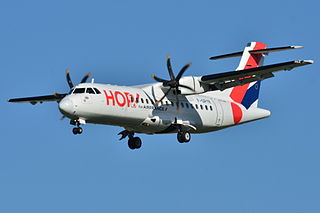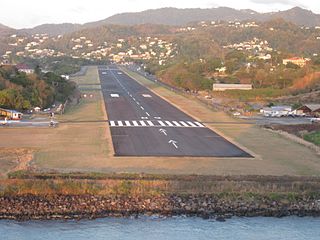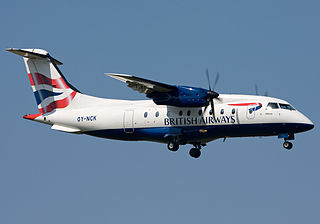
ATR is a Franco-Italian aircraft manufacturer headquartered in Blagnac, France, a suburb of Toulouse.
Air Wisconsin Airlines is a regional airline based at Appleton International Airport in the town of Greenville, Wisconsin, near Appleton. Air Wisconsin originally operated as one of the original United Express partners in 1985, and subsequently operated as US Airways Express on behalf of US Airways prior to becoming an American Eagle regional air carrier. Between March 2018 and April 2023, Air Wisconsin operated exclusively as a United Express regional air carrier once again with primary hubs located at Chicago's O'Hare International Airport (ORD) and Washington Dulles International Airport (IAD). This came to an end in April 2023 as the carrier switched to conducting solely American Eagle branded flights, per a new contract with American Airlines.

A regional airliner or a feeder liner is a small airliner that is designed to fly up to 100 passengers on short-haul flights, usually feeding larger carriers' airline hubs from small markets. This class of airliners is typically flown by the regional airlines that are either contracted by or subsidiaries of the larger airlines. Regional airliners are used for short trips between smaller towns or from a larger city to a smaller city. Feeder liner, commuter, and local service are all alternative terms for the same class of flight operations.

The ATR 42 is a regional airliner produced by Franco-Italian manufacturer ATR, with final assembly in Toulouse, France. On 4 November 1981, the aircraft was launched with ATR, as a joint venture between French Aérospatiale and Aeritalia . The ATR 42-300 performed its maiden flight on 16 August 1984 and type certification was granted during September 1985. Launch customer Air Littoral operated its first revenue-earning flight in December of that year.

The Hawker Siddeley HS 748 is a medium-sized turboprop airliner originally designed and initially produced by the British aircraft manufacturer Avro. It was the last aircraft to be developed by Avro prior to its absorption into Hawker Siddeley.

The British Aerospace 146 is a short-haul and regional airliner that was manufactured in the United Kingdom by British Aerospace, later part of BAE Systems. Production ran from 1983 until 2001. Avro International Aerospace manufactured an improved version known as the Avro RJ. Production for the Avro RJ version began in 1992. Later on, a further-improved version with new engines, the Avro RJX, was announced in 1997, but only two prototypes and one production aircraft were built before production ceased in 2001. With 387 aircraft produced, the Avro RJ/BAe 146 is the most successful British civil jet airliner program.

George F. L. Charles Airport is the smaller of the two airports in Saint Lucia, the other being Hewanorra International Airport. It is located 2 km (1.2 mi) north of Castries, the capital city. George F. L. Charles Airport is managed by the Saint Lucia Air and Seaports Authority (SLASPA). Its runway runs parallel to a pristine beach, Vigie Beach, which is a popular tourist attraction.

The Handley Page HP.137 Jetstream is a small twin-turboprop airliner, with a pressurised fuselage. The aircraft was designed to meet the requirements of the United States commuter and regional airline market. The design was later improved and built by British Aerospace as the BAe Jetstream 31 and BAe Jetstream 32, featuring different turboprop engines.
Trans States Airlines was a regional airline in the United States that operated from 1982 until 2020, when it shut down due to the COVID-19 pandemic. It was owned by Trans States Holdings and headquartered in Bridgeton, Missouri. At the time of its closing, the airline operated flights for United Airlines under the United Express brand. Trans States Airlines ceased all operations on April 1, 2020.

Dan-Air was an airline based in the United Kingdom and a wholly owned subsidiary of London-based shipbroking firm Davies and Newman. It was started in 1953 with a single aircraft. Initially, it operated cargo and passenger charter flights from Southend (1953–1955) and Blackbushe airports (1955–1960) using a variety of piston-engined aircraft before moving to a new base at Gatwick Airport in 1960, followed by expansion into inclusive tour (IT) charter flights and all-year round scheduled services. The introduction of two de Havilland Comet series 4 jet aircraft in 1966 made Dan-Air the second British independent airline after British United Airways to begin sustained jet operations.

The British Aerospace Jetstream 41 is a turboprop-powered feederliner and regional airliner, designed by British Aerospace as a stretched version of the popular Jetstream 31. Intended to compete directly with 30-seat aircraft like the Embraer Brasilia, Dornier 328 and Saab 340, the new design eventually accommodated 29 passengers in a two-by-one arrangement like the Jetstream 31. Eastern Airways of the UK is the biggest operator of Jetstream 41s in the world, with 14 in the fleet.

The Fokker 50 is a turboprop-powered airliner manufactured and supported by Dutch aircraft manufacturer Fokker. It was designed as an improved version of the successful Fokker F27 Friendship. The Fokker 60 is a stretched freighter version of the Fokker 50.

SATA Air Açores is a Portuguese airline based in São Sebastião, Ponta Delgada in the Azores, Portugal. It operates scheduled passenger, cargo and mail services around the Azores. It provides its own maintenance and handling services and manages four regional airports. Its main base is at João Paulo II Airport, Ponta Delgada. It also maintains a subsidiary for mid- and long-haul flights, Azores Airlines, the former SATA International.
West Air Sweden, operating as West Atlantic, is a cargo airline based in Malmö, Sweden. It operates scheduled and ad hoc freight charter services for FedEx, DHL and UPS. It is also contracted to operate mail flights for different postal services within Europe. Its main bases are Charles de Gaulle Airport and Oslo Airport, Gardermoen.
West Atlantic UK Limited, formerly Atlantic Airlines Ltd is a British cargo airline based at East Midlands Airport. It operates contract and ad hoc cargo flights worldwide, especially within Europe as part of the West Atlantic Group. The company's fleet is composed of Boeing 737 and ATR72 aircraft. The airline specialises in the transport of dangerous goods and radioactive products and other specialist aerial work, including oil spill response, dispersant spraying and icing trials. The prime activity of the business is the supply and operating of aircraft to night-time freight integrators and consolidators and the operation of ad hoc air charters on behalf of other airlines, freight brokers and forwarders. Atlantic Airlines merged with the Swedish airline "West Air Europe" in 2008 to establish the West Atlantic Group.

The Beechcraft 1900 is a twin-engine turboprop regional airliner manufactured by Beechcraft. It is also used as a freight aircraft and corporate transport, and by several governmental and military organizations. With customers favoring larger regional jets, Raytheon ended production in October 2002.

The Dornier 328 is a turboprop-powered commuter airliner. Initially produced by Dornier Luftfahrt GmbH, the firm was acquired in 1996 by Fairchild Aircraft. The resulting firm, named Fairchild-Dornier, manufactured the 328 family in Oberpfaffenhofen, Germany, conducted sales from San Antonio, Texas, United States, and supported the product line from both locations. A jet-powered version of the aircraft, the Fairchild Dornier 328JET, was also produced.
Seven Four Eight Air Services, also known doing business as 748 Air Services is a charter airline operating in the passenger and cargo business. Its head office is in Wilson Airport in Nairobi, Kenya.

Clic Air is a regional carrier that operates in Colombia. Its main focus is to serve intermediate cities and those not served by other carriers. Operations started in October 2007, with one British Aerospace Jetstream 41 aircraft. Its main base is El Dorado International Airport, Bogotá. Alfonso Ávila, the founder of EasyFly, was also one of the founders of Aero República in 1992.

The British Aerospace Jetstream is a small twin turboprop airliner, with a pressurised fuselage, developed as the Jetstream 31 from the earlier Handley Page Jetstream. A larger version of the Jetstream was also manufactured, the British Aerospace Jetstream 41.


















